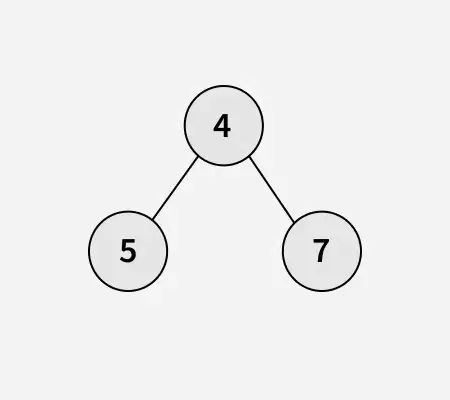dado un árbol n-ario que contienen valores de nodo positivos, la tarea es encontrar el profundidad del árbol.
Nota: Un árbol n-ario es un árbol donde cada nodo puede tener cero o más nodos hijos. A diferencia de un árbol binario que tiene como máximo dos hijos por nodo (izquierda y derecha) el árbol n-ario permite múltiples sucursales o hijos para cada nodo.
Ejemplos:
Aporte:
Producción: 3
Explicación: El camino más largo desde la raíz (nodo 81) hasta una hoja es 81 -> 26 -> 95 u 81 -> 26 -> 86, lo que da una profundidad máxima de 3.Aporte:

Producción: 2
Explicación: El camino más largo desde la raíz (nodo 4) hasta cualquier hoja (nodos 5 o 7) es 2, ya que solo requiere dos niveles de recorrido.registrar memoria
Acercarse:
La idea es calcular el profundidad de un árbol N-ario recursivamente inicializar el profundidad máxima como 0 luego calcula recursivamente el profundidad para cada niño y realizar un seguimiento de la mayor profundidad encontrado. Finalmente agregar 1 a la profundidad máxima (para el nodo actual) y devolver el resultado . Este enfoque garantiza que encontremos la camino más largo desde la raíz hasta cualquier nodo de la hoja.
El árbol N-Ary se puede recorrer como un árbol normal. Solo tenemos que considerar todos los hijos de un nodo determinado y llamar recursivamente a esa función en cada nodo.
C++// C++ Code to find the depth of an N-ary tree #include
// Java Code to find the depth of an N-ary tree import java.util.*; class Node { int data; List<Node> children; Node(int val) { data = val; children = new ArrayList<>(); } } // Recursive function to calculate // maximum depth class GfG { static int maxDepth(Node root) { // If the node is null depth is 0 if (root == null) { return 0; } int depth = 0; // Recur for all children and find // the maximum depth for (Node child : root.children) { depth = Math.max(depth maxDepth(child)); } // Add 1 to include the current node // in the depth count return depth + 1; } public static void main(String[] args) { // Representation of given N-ary tree // 1 // / | // 2 3 4 // / // 5 6 Node root = new Node(1); root.children.add(new Node(2)); root.children.add(new Node(3)); root.children.add(new Node(4)); root.children.get(0).children.add(new Node(5)); root.children.get(2).children.add(new Node(6)); System.out.println(maxDepth(root)); } }
# Python Code to find the depth # of an N-ary tree class Node: def __init__(self val): self.data = val self.children = [] # Recursive function to calculate # maximum depth def max_depth(root): # If the node is None depth is 0 if not root: return 0 depth = 0 # Recur for all children and # find the maximum depth for child in root.children: depth = max(depth max_depth(child)) # Add 1 to include the current # node in the depth count return depth + 1 if __name__ == '__main__': # Representation of given N-ary tree # 1 # / | # 2 3 4 # / # 5 6 root = Node(1) root.children.append(Node(2)) root.children.append(Node(3)) root.children.append(Node(4)) root.children[0].children.append(Node(5)) root.children[2].children.append(Node(6)) print(max_depth(root))
// C# Code to find the depth of an N-ary tree using System; using System.Collections.Generic; class Node { public int data; public List<Node> children; public Node(int val) { data = val; children = new List<Node>(); } } // Recursive function to calculate // maximum depth class GfG { static int MaxDepth(Node root) { // If the node is null depth is 0 if (root == null) { return 0; } int depth = 0; // Recur for all children and find the maximum depth foreach (Node child in root.children) { depth = Math.Max(depth MaxDepth(child)); } // Add 1 to include the current // node in the depth count return depth + 1; } static void Main(string[] args) { // Representation of given N-ary tree // 1 // / | // 2 3 4 // / // 5 6 Node root = new Node(1); root.children.Add(new Node(2)); root.children.Add(new Node(3)); root.children.Add(new Node(4)); root.children[0].children.Add(new Node(5)); root.children[2].children.Add(new Node(6)); Console.WriteLine(MaxDepth(root)); } }
// JavaScript Code to find the depth // of an N-ary tree class Node { constructor(val) { this.data = val; this.children = []; } } // Recursive function to calculate // maximum depth function maxDepth(root) { // If the node is null depth is 0 if (!root) { return 0; } let depth = 0; // Recur for all children and find // the maximum depth for (let child of root.children) { depth = Math.max(depth maxDepth(child)); } // Add 1 to include the current node // in the depth count return depth + 1; } // Representation of given N-ary tree // 1 // / | // 2 3 4 // / // 5 6 const root = new Node(1); root.children.push(new Node(2)); root.children.push(new Node(3)); root.children.push(new Node(4)); root.children[0].children.push(new Node(5)); root.children[2].children.push(new Node(6)); console.log(maxDepth(root));
Producción
3
Complejidad del tiempo: O(n) ya que cada nodo se visita una vez, donde n es el número total de nodos en el árbol N-ario.
Espacio Auxiliar: O(h) donde h es la altura del árbol debido al uso recursivo de la pila de llamadas.


